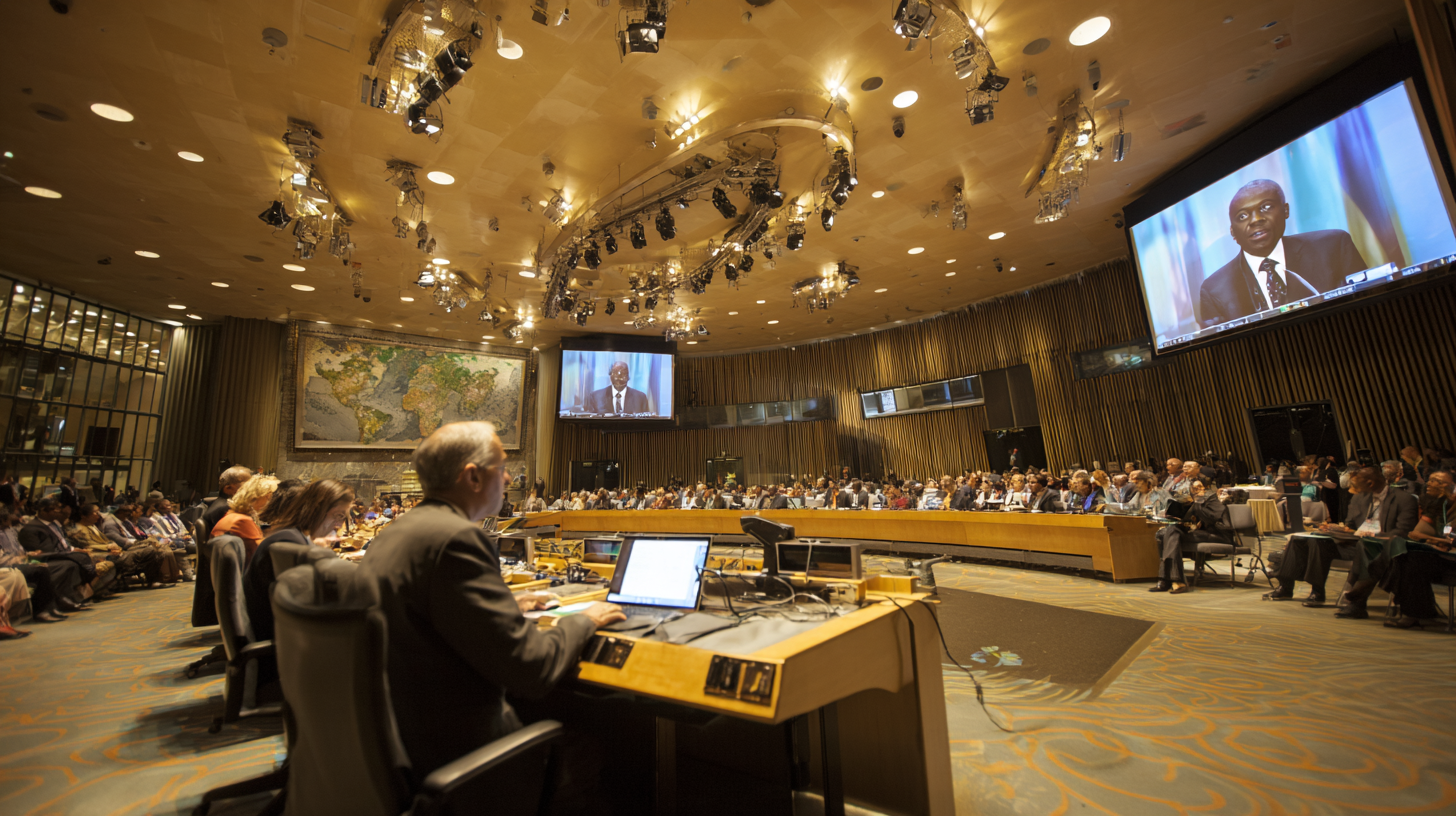The United Nations Environment Programme (UNEP) plays a pivotal role in promoting sustainable development across the globe, serving as a catalyst for environmental stewardship and policy advocacy. According to the 2021 "Global Environment Outlook" report, overwhelming evidence highlights that urgent action is required to combat environmental degradation, with the world's ecosystems facing unprecedented challenges, including biodiversity loss and climate change. As nations prepare to meet the ambitious targets set by the Sustainable Development Goals (SDGs), UNEP's strategic initiatives aim to align environmental sustainability with economic growth and social equity. Recent data from the International Renewable Energy Agency indicates that transitioning to renewable energy sources could contribute up to $10 trillion to the global economy by 2030, underscoring the potential for sustainable practices to drive innovation and development. In this context, UNEP's efforts are crucial in guiding global policy and fostering partnerships to ensure that economic pursuits do not come at the expense of our planet's health.

The United Nations Environment Programme (UNEP) plays a pivotal role in global sustainability efforts by addressing pressing environmental challenges through innovative strategies and collaborative initiatives. According to the Global Environment Outlook 6 report, about 1 million species are facing extinction, many within decades, underscoring the urgent need for effective environmental governance. UNEP facilitates various programs aimed at protecting biodiversity, promoting sustainable resource management, and combatting climate change, which collectively contribute to the health of our planet and the wellbeing of its inhabitants.
Moreover, UNEP's emphasis on sustainable development aligns with the United Nations' 2030 Agenda, specifically the Sustainable Development Goals (SDGs). It reports that achieving these goals can potentially unlock an estimated $12 trillion in market opportunities and create 380 million jobs by 2030. By advancing integrated environmental policies, UNEP encourages nations to invest in clean technologies and sustainable practices that not only help mitigate environmental degradation but also promote economic resilience. The collaborative efforts of UNEP are therefore essential in fostering a sustainable future for both people and the planet, showcasing the interconnectedness of environmental stewardship and socioeconomic development.
This chart illustrates the distribution of global greenhouse gas emissions by sector in 2019. Understanding which sectors contribute the most to emissions is crucial for targeted sustainability efforts.
The United Nations Environment Programme (UNEP) plays a pivotal role in advancing sustainable development through various key initiatives aimed at environmental protection and the promotion of sustainable practices. One of the flagship programs is the "Ecosystem-Based Adaptation" (EbA), which employs nature-based solutions to enhance resilience against climate change. According to a UNEP report, investing in EbA methods could yield a return of up to $30 for every $1 spent, demonstrating the economic advantages of integrating ecosystem services into climate planning.
Additionally, UNEP's "Clean Seas" initiative tackles marine pollution by reducing plastic waste in oceans, targeting the alarming statistic that over 11 million metric tons of plastic enter marine environments each year. The program emphasizes the importance of national commitments and public engagement in curbing this tide of pollution. As highlighted in a recent report, nations participating in the Clean Seas initiative have collectively pledged to reduce marine litter by 50% by 2030, showcasing a concerted global effort to protect aquatic ecosystems.
Furthermore, UNEP's Climate Change Mitigation programs promote energy efficiency and renewable energy usage across various sectors. The latest Global Energy Transformation Report reveals that achieving a sustainable energy future could prevent approximately 4 million premature deaths and save over $8 trillion in health-related costs by 2040. These initiatives reflect UNEP's commitment to fostering sustainable practices while addressing critical environmental challenges on a global scale.
The United Nations Environment Programme (UNEP) plays a pivotal role in fostering strategic partnerships and collaborations essential for effective environmental governance. In the pursuit of sustainable development, UNEP collaborates with governments, NGOs, and private sectors, leveraging diverse expertise and resources. According to the Global Environment Outlook 6 (GEO-6) report, over 70% of environmental policies benefit from multi-stakeholder dialogues and cooperative frameworks. This interdisciplinary approach enhances policy implementation and resource mobilization, leading to better environmental outcomes.
Moreover, partnerships are critical in addressing global challenges such as climate change and biodiversity loss. UNEP's collaboration with organizations like the World Bank and the International Union for Conservation of Nature (IUCN) has resulted in significant projects that report a potential increase of 8% in ecosystem resilience globally. Furthermore, initiatives such as the 2030 Agenda for Sustainable Development emphasize the importance of collaborative partnerships in achieving the Sustainable Development Goals (SDGs), with Goal 17 explicitly highlighting the need for strengthening the means of implementation through partnerships across various sectors. These strategic alliances not only amplify the impact of environmental governance but also foster innovation and knowledge sharing necessary for a sustainable future.

The United Nations Environment Programme (UNEP) plays a crucial role in driving sustainable development through robust indicators and metrics that measure progress towards its Sustainable Development Goals (SDGs). By establishing clear frameworks for evaluation, UNEP enables nations and organizations to assess their environmental impact, resource usage, and overall sustainability. These metrics not only reflect compliance with international standards but also foster accountability among member states, encouraging them to adopt efficient and environmentally friendly practices.
To measure success effectively, UNEP emphasizes the integration of quantitative and qualitative data. Quantitative indicators, such as greenhouse gas emissions, biodiversity indices, and water quality metrics, provide a concrete picture of environmental health. Meanwhile, qualitative measures, including stakeholder engagement and community well-being surveys, offer insights into social dimensions of sustainability. This comprehensive approach helps stakeholders identify challenges and opportunities, guiding policy adjustments and strategic initiatives aimed at enhancing sustainable practices worldwide. Through this systematic evaluation, UNEP reinforces its commitment to fostering resilience and sustainability across global ecosystems.
| Indicator | Description | Current Status | Target Year |
|---|---|---|---|
| SDG 1: No Poverty | Percentage of population living below the national poverty line | 15% | 2030 |
| SDG 4: Quality Education | Net enrollment rate in primary education | 90% | 2030 |
| SDG 6: Clean Water and Sanitation | Proportion of population using safely managed drinking water services | 85% | 2030 |
| SDG 7: Affordable and Clean Energy | Percentage of population with access to electricity | 95% | 2030 |
| SDG 13: Climate Action | Number of countries that have communicated their long-term low greenhouse gas development strategies | 100 | 2025 |
The United Nations Environment Programme (UNEP) plays a crucial role in promoting sustainable development by addressing a range of environmental challenges that the world faces today. With increasing pressures from climate change, biodiversity loss, and pollution, UNEP's mission is more vital than ever. However, the pathway to achieving sustainable development is fraught with complexities. Coordination between countries, stakeholders, and sectors is essential to address environmental issues effectively. Initiatives like the recent One Health Action Committee workshop demonstrate the importance of collaborative approaches, focusing not just on environmental sustainability but also on public health and ecosystem resilience.
Looking ahead, UNEP must navigate various challenges in implementing effective environmental strategies. The need for innovative policies that integrate health and environmental objectives has never been clearer, especially as global health concerns are intertwined with environmental conditions. Future directions for UNEP should prioritize enhancing multi-sectoral partnerships and fostering cross-border collaborations, as exemplified by recent initiatives. By embracing a holistic approach and engaging diverse stakeholders, UNEP can better tackle the pressing environmental issues while facilitating sustainable development that encompasses all facets of human and ecological well-being.







